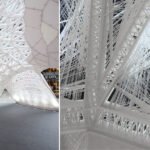Interactive architecture: Buildings that respond to users
- By -Peter
- Posted on
- Posted in Modern Architecture
Interactive architecture represents a dynamic shift in how buildings engage with occupants, offering personalized experiences and enhancing functionality through responsive design and innovative technologies. Here’s an exploration of the evolving field of interactive architecture and its impact on user interaction and building performance.
1. Sensor-Based Environments
Adaptive Environments:
- Occupancy Sensors: Detecting user presence and adjusting lighting, temperature, and ventilation systems to optimize comfort and energy efficiency.
- Gesture Recognition: Utilizing motion sensors and computer vision to interpret user gestures and trigger responsive actions within building spaces.
2. Responsive Facades and Interiors
Dynamic Building Skins:
- Kinetic Architecture: Incorporating movable façade elements and adaptive shading systems that respond to environmental conditions and user preferences.
- Interactive Displays: Embedding interactive screens and digital projections on building surfaces to provide information, art displays, or interactive games for public engagement.
3. Smart Building Systems
Integrated Technologies:
- IoT Connectivity: Connecting building systems and devices to a centralized network for real-time monitoring, data analytics, and predictive maintenance.
- Voice and Touch Controls: Offering intuitive interfaces for occupants to control lighting, HVAC, security, and entertainment systems through voice commands or touch-enabled interfaces.

4. User-Centric Design Principles
Human-Centered Environments:
- Personalization: Adapting space configurations and ambient settings based on individual user preferences, habits, and needs.
- Accessibility: Designing inclusive spaces that accommodate diverse user abilities and sensory experiences through universal design principles.
5. Interactive Installations and Artistic Interventions
Public Engagement:
- Interactive Art Installations: Collaborating with artists and designers to create immersive artworks that respond to user interactions and environmental stimuli.
- Augmented Reality (AR) Experiences: Integrating AR technologies to overlay digital information and interactive content onto physical building spaces, enhancing storytelling and educational experiences.
6. Environmental Sustainability
Energy-Efficient Practices:
- Natural Ventilation Systems: Utilizing responsive building designs that harness natural airflow and daylighting to minimize energy consumption.
- Green Building Certifications: Incorporating sustainable materials, renewable energy sources, and water-efficient technologies to achieve LEED or BREEAM certifications.
7. Case Studies and Innovative Examples
Exemplary Projects:
- The Edge, Amsterdam: A smart, sustainable office building featuring sensor-driven lighting, climate control, and personalized workspace settings.
- Museo Soumaya, Mexico City: An iconic museum with a dynamic aluminum façade that changes appearance throughout the day, engaging visitors with its interactive design.
8. Future Trends and Technological Advancements
Emerging Innovations:
- Biometric Interfaces: Integrating biometric sensors to personalize user experiences based on physiological responses such as heart rate or stress levels.
- Predictive Analytics: Using machine learning algorithms to anticipate user behavior patterns and optimize building operations in real-time.
Conclusion
Interactive architecture represents a paradigm shift in architectural design, offering buildings that not only accommodate but actively engage with their users. By harnessing responsive technologies, smart building systems, and innovative design strategies, architects can create dynamic environments that enhance user experience, promote sustainability, and foster community interaction. As the field continues to evolve, the possibilities for interactive architecture are limitless, paving the way for more adaptive, resilient, and user-centric built environments that redefine the future of urban living and public spaces.



